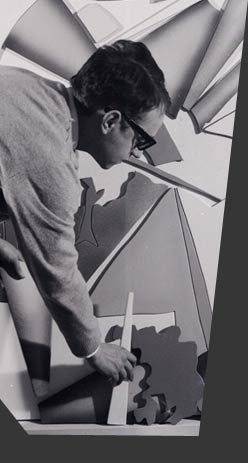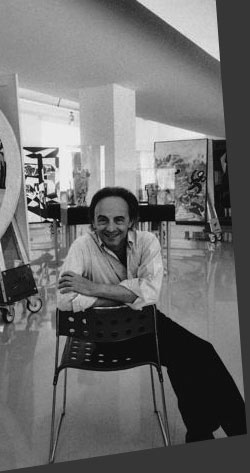Gillo Dorfles
NESPOLO'S CARPETS
Not everybody is able to take a certain material and bend it to his will and make it necessarily «artistic» just by following his own individual taste to the contrary, what often happens is that an artist comes to be so conditioned by a particular expressive medium that he ends up by being yoked by it and it may well even happen that it is the material itself that «imposes» the form and the structure a work is to take.
As far as Nespolo is concerned - this veritable Peter Pan by now in his late forties (but he wears well, looking about thirty) and ever abounding in «the joys of science» - the very opposite takes place.
It may seem hard to believe, but in his hands a piece of ceramics or a carpet, a painting or a set design and even a film (and he has produced quite a number) at once becomes the very «incarnation» of the highly personal style of this Piedmontese artist. Should I try to define his style it would serve no purpose at all to refer to distant roots set in Futurism or to draw likenesses with the more recent trends of Pop Art, so l prefer simply to look upon it as autonomous and inborn and, as such, fully weathered and able to «withstand » any type of transformation.
We can appreciate this full well in the present series of seven carpets (made with splendid technique and outstanding material by Elio Palmisano's Edizioni Tessili, remaining absolutely true to the chromatic tones) where the artist has, yet again, shown how «artisan/craftsman » production can in every way match a work of «pure art», provided the demands of the medium used to create it are borne in mind, as well as the scale and the function, which, in this case, is clearly-defined: an object for furnishing the home.
This series of seven carpets has been created by Nespolo using one of his many play-oriented approaches: in this case using letters, musical notes, numbers, flowers, butterflies and leaves, all crowned by a magnificent «Homage to Paul Klee».
The contents are, however, of a relative bearing in these works and are geared, more than anything else, towards giving the viewer (in this case, the carpet «treader») the opportunity to reflect on this dovetailing of signs and colours and discover the hidden presence of musical notes and numbers or, in the case of the homage to Klee, to amuse himself fathoming out what is written in the various squares making up the composition.
At times, however, a «figurative» aspect gains the upper hand: like with the large «leaf», which proves one of the most well-balanced carpets, one of the most pleasing to the eye; then again with the «notes», which is one of the most successful works due to the striking yet refined contrasting shades, and with the giant carpet of «letters» which is rather like a page to be read by all those lucky enough to pace up and down the vast area it covers... However, as I was saying, it is not the semantic aspect - the explicit meaning of the motifs that have been chosen - that really counts; it is the overall result that has most bearing, like with so many of the artist s other works. Here we are up against a further proposal of how, as I was saying earlier, those qualities of geometric rhythm and free-reined creative vein, coupled with bold colour tones and a refined search for unusual nuances, can show that artisan/craftsman production like these carpets is able to offer the viewer the full range of the stylistic characteristics of an artist, without losing any of them; to the contrary, at times, the expressive qualities are brought out all the more.
(From the book: 7 tappeti di Ugo Nespolo â Elio Palmisano, Edizioni Tessili, Palazzo della Permanente, Milano, 1987)



